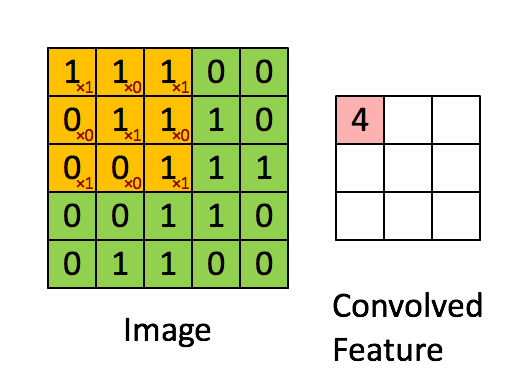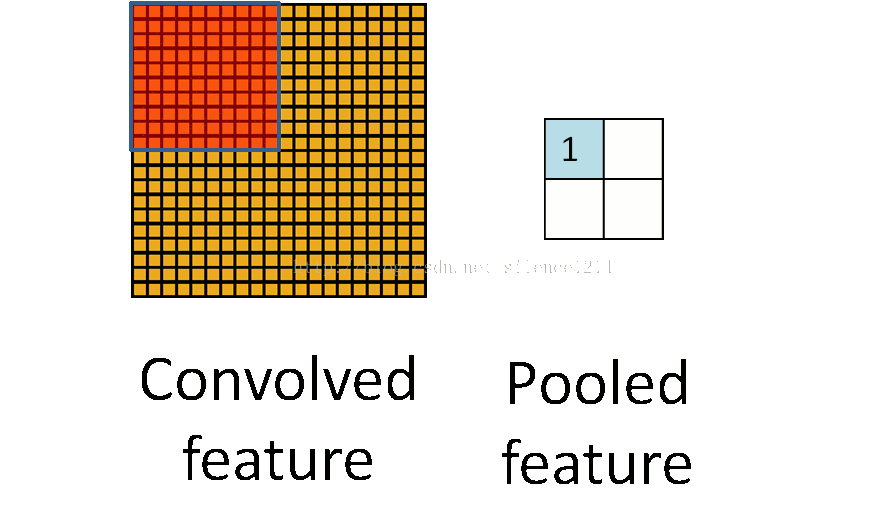先用CNN提取特征,之后用SVM分类,平台是TensorFlow 1.6.0-rc0,python2.7
这个是我的一个小小的测试,下面这个链接是我主要参考的,在实现过程中,本来想使用vgg16或者VGG19做迁移来提取特征,但是担心自己的算力不够,还有就是UCI手写数据集本来就是一个不大的数据集,使用vgg16或vgg19有点杀鸡用牛刀的感觉。于是放弃做迁移。
我的代码主要是基于下面链接来的。参考链接点击打开链接
这个代码主要是,通过一个CNN网络,在网络的第一个全连接层也就h_fc1得到的一个一维的256的一个特征向量,将这个特征向量作为的svm的输入。主要的操作是在代码行的140-146. 同时代码也实现了CNN的过程(读一下代码就知道)。
如果你要是知道你的CNN的结构,然后就知道在全连接层输出的其实就是一个特征向量。直接用这个特征向量简单处理输入到svm中就可以。
具体的参考论文和代码数据集等,百度网盘
目标是对UCI的手写数字数据集进行识别,样本数量大约是1600个。图片大小为16x16。要求必须使用SVM作为二分类的分类器。
本文重点是如何使用卷积神经网络(CNN)来提取手写数字图片特征,主要想看如何提取特征的请直接看源代码部分的94行左右,只要对tensorflow有一点了解就可以看懂。在最后会有完整的源代码、处理后数据的分享链接。转载请保留原文链接,谢谢。
UCI手写数字的数据集
源数据下载:http://oddmqitza.bkt.clouddn.com/archivetempsemeion.data
其中前256维为16x16的图片,后10维为one hot编码的标签。即0010000000代表2,1000000000代表0.
组合成图片大约是这样的:

卷积和池化形象理解
卷积

池化

仔细的看,慢慢想就能明白CNN提取特征的思想巧妙之处。
能明白这两点,剩下的东西就和普通的神经网络区别不大了。
为什么要用CNN提取特征?
1.由于卷积和池化计算的性质,使得图像中的平移部分对于最后的特征向量是没有影响的。从这一角度说,提取到的特征更不容易过拟合。而且由于平移不变性,所以平移字符进行变造是无意义的,省去了再对样本进行变造的过程。
2.CNN抽取出的特征要比简单的投影、方向,重心都要更科学。不会让特征提取成为最后提高准确率的瓶颈、天花板
3.可以利用不同的卷积、池化和最后输出的特征向量的大小控制整体模型的拟合能力。在过拟合时可以降低特征向量的维数,在欠拟合时可以提高卷积层的输出维数。相比于其他特征提取方法更加灵活
CNN卷积层简介
CNN,有两个卷积(5*5)池化层(2*2的maxPooling),然后两个全连接层h_fc1和h_fc2,我只使用第一个全连接层h_fc1就提取了特征。
然后中间的激活函数使用的是relu函数,同时为了防止过拟合使用了dropout的技巧。然后这个代码中其实是实现了完整的CNN的的预测的,损失使用交叉熵,优化器使用了AdamOptimizer。

图片大小的变化:

最后从全连接层提取的256维的向量。输入svm。
SVM分类
SVM采用的是RBF核(高斯核),C取0.9
也可以尝试线性核,我试了一下效果差不多,但是没有高斯核分类效率好。
流程和实验设计
流程:整理训练网络的数据,对样本进行处理 -> 建立卷积神经网络-> 将数据代入进行训练 -> 保存训练好的模型(从全连接层提取特征) -> 把数据代入模型获得特征向量 -> 用特征向量代替原本的输入送入SVM训练 -> 测试时同样将h_fc1转换为特征向量之后用SVM预测,获得结果。
使用留出法样本处理和评价:
1.将原样本随机地分为两半。一份为训练集,一份为测试集
2.重复1过程十次,得到十个训练集和十个对应的测试集
3.取十份训练集中的一份和其对应的测试集。代入到CNN和SVM中训练。
4.依次取训练集和测试集,则可完成十次第一步。
5.将十次的表现综合评价,十次验证取平均值,计算正确率、准确率、召回率、F1值。比如 F1 分数 , 用于测量不均衡数据的精度.
-
-
-
-
-
-
-
from sklearn
import preprocessing
-
-
right0 =
0.0
# 记录预测为1且实际为1的结果数
-
error0 =
0
# 记录预测为1但实际为0的结果数
-
right1 =
0.0
# 记录预测为0且实际为0的结果数
-
error1 =
0
# 记录预测为0但实际为1的结果数
-
-
for file_num
in range(
10):
-
# 在十个随机生成的不相干数据集上进行测试,将结果综合
-
print(
'testing NO.%d dataset.......' % file_num)
-
ff = open(
'digit_train_' + file_num.__str__() +
'.data')
-
-
-
-
-
-
x_test2.append(list(map(int, map(float, rr[i].split(
' ')[:
256]))))
-
y_test2.append(list(map(int, rr[i].split(
' ')[
256:
266])))
-
-
-
ff2 = open(
'digit_test_' + file_num.__str__() +
'.data')
-
-
-
-
for i
in range(len(rr2)):
-
x_test3.append(list(map(int, map(float, rr2[i].split(
' ')[:
256]))))
-
y_test3.append(list(map(int, rr2[i].split(
' ')[
256:
266])))
-
-
-
-
sess = tf.InteractiveSession()
-
-
-
-
-
-
def weight_variable(shape):
-
initial = tf.truncated_normal(shape, stddev=
0.1)
-
return tf.Variable(initial)
-
-
-
-
def bias_variable(shape):
-
initial = tf.constant(
0.1, shape=shape)
-
return tf.Variable(initial)
-
-
-
-
-
return tf.nn.conv2d(x, W, strides=[
1,
1,
1,
1], padding=
'SAME')
-
-
-
-
-
return tf.nn.max_pool(x, ksize=[
1,
2,
2,
1], strides=[
1,
2,
2,
1], padding=
'SAME')
-
-
-
-
x = tf.placeholder(
"float", [
None,
256])
-
y_ = tf.placeholder(
"float", [
None,
10])
-
-
W = tf.Variable(tf.zeros([
256,
10]))
-
b = tf.Variable(tf.zeros([
10]))
-
# 计算输出,采用的函数是softmax(输入的时候是one hot编码)
-
y = tf.nn.softmax(tf.matmul(x, W) + b)
-
# 第一个卷积层,5x5的卷积核,输出向量是32维
-
w_conv1 = weight_variable([
5,
5,
1,
32])
-
b_conv1 = bias_variable([
32])
-
x_image = tf.reshape(x, [
-1,
16,
16,
1])
-
# 图片大小是16*16,,-1代表其他维数自适应
-
h_conv1 = tf.nn.relu(conv2d(x_image, w_conv1) + b_conv1)
-
h_pool1 = max_pool_2x2(h_conv1)
-
# 采用的最大池化,因为都是1和0,平均池化没有什么意义
-
-
# 第二层卷积层,输入向量是32维,输出64维,还是5x5的卷积核
-
w_conv2 = weight_variable([
5,
5,
32,
64])
-
b_conv2 = bias_variable([
64])
-
-
h_conv2 = tf.nn.relu(conv2d(h_pool1, w_conv2) + b_conv2)
-
h_pool2 = max_pool_2x2(h_conv2)
-
-
-
w_fc1 = weight_variable([
4 *
4 *
64,
256])
-
b_fc1 = bias_variable([
256])
-
-
h_pool2_flat = tf.reshape(h_pool2, [
-1,
4 *
4 *
64])
-
h_fc1 = tf.nn.relu(tf.matmul(h_pool2_flat, w_fc1) + b_fc1)
-
# h_fc1是提取出的256维特征,很关键。后面就是用这个输入到SVM中
-
-
-
keep_prob = tf.placeholder(
"float")
-
h_fc1_drop = tf.nn.dropout(h_fc1, keep_prob)
-
-
# 输出层,在本实验中只利用它的输出反向训练CNN,至于其具体数值我不关心
-
w_fc2 = weight_variable([
256,
10])
-
b_fc2 = bias_variable([
10])
-
-
y_conv = tf.nn.softmax(tf.matmul(h_fc1_drop, w_fc2) + b_fc2)
-
cross_entropy = -tf.reduce_sum(y_ * tf.log(y_conv))
-
-
train_step = tf.train.AdamOptimizer(
1e-4).minimize(cross_entropy)
-
-
correct_prediction = tf.equal(tf.argmax(y_conv,
1), tf.argmax(y_,
1))
-
accuracy = tf.reduce_mean(tf.cast(correct_prediction,
"float"))
-
sess.run(tf.global_variables_initializer())
-
-
# 跑3000轮迭代,每次随机从训练样本中抽出50个进行训练
-
-
p = random.sample(range(
795),
50)
-
-
batch[
0].append(x_test2[k])
-
batch[
1].append(y_test2[k])
-
-
train_accuracy = accuracy.eval(feed_dict={x: batch[
0], y_: batch[
1], keep_prob:
1.0})
-
# print "step %d, train accuracy %g" % (i, train_accuracy)
-
train_step.run(feed_dict={x: batch[
0], y_: batch[
1], keep_prob:
0.6})
-
# 设置dropout的参数为0.6,测试得到,大点收敛的慢,小点立刻出现过拟合
-
-
print(
"test accuracy %g" % accuracy.eval(feed_dict={x: x_test3, y_: y_test3, keep_prob:
1.0}))
-
-
# y = tf.nn.softmax(tf.matmul(sess.run(x), W) + b)
-
-
for h
in range(len(y_test2)):
-
if np.argmax(y_test2[h]) ==
7:
-
-
-
-
for h
in range(len(y_test3)):
-
if np.argmax(y_test3[h]) ==
7:
-
-
-
-
# 以上两步都是为了将源数据的one hot编码改为1和0,我的学号尾数为7
-
-
-
x_temp.append(sess.run(h_fc1, feed_dict={x: np.array(g).reshape((
1,
256))})[
0])
-
# 将原来的x带入训练好的CNN中计算出来全连接层的特征向量,将结果作为SVM中的特征向量
-
-
-
x_temp2.append(sess.run(h_fc1, feed_dict={x: np.array(g).reshape((
1,
256))})[
0])
-
-
clf = svm.SVC(C=
0.9, kernel=
'linear')
# linear kernel
-
# clf = svm.SVC(C=0.9, kernel='rbf') #RBF kernel
-
-
# x_temp = preprocessing.scale(x_temp) #normalization
-
-
-
-
print(
'svm testing accuracy:')
-
print(clf.score(x_temp2, y_test3))
-
-
for j
in range(len(x_temp2)):
-
-
# 这里报错了,需要对其进行reshape(1,-1)
-
if clf.predict(x_temp2[j].reshape(
1,
-1))[
0] == y_test3[j] ==
1:
-
-
elif clf.predict(x_temp2[j].reshape(
1,
-1))[
0] == y_test3[j] ==
0:
-
-
elif clf.predict(x_temp2[j].reshape(
1,
-1))[
0] ==
1
and y_test3[j] ==
0:
-
-
-
-
-
accuracy = right0 / (right0 + error0)
# 准确率
-
recall = right0 / (right0 + error1)
# 召回率
-
print(
'svm right ratio ', (right0 + right1) / (right0 + right1 + error0 + error1))
-
print (
'accuracy ', accuracy)
-
print (
'recall ', recall)
-
print (
'F1 score ',
2 * accuracy * recall / (accuracy + recall))
# 计算F1值
testing NO.0 dataset.......
2019-02-26 10:56:38.034846: I tensorflow/stream_executor/cuda/cuda_gpu_executor.cc:898] successful NUMA node read from SysFS had negative value (-1), but there must be at least one NUMA node, so returning NUMA node zero
2019-02-26 10:56:38.035075: I tensorflow/core/common_runtime/gpu/gpu_device.cc:1212] Found device 0 with properties:
name: GeForce GTX 1050 Ti major: 6 minor: 1 memoryClockRate(GHz): 1.62
pciBusID: 0000:01:00.0
totalMemory: 3.95GiB freeMemory: 3.51GiB
2019-02-26 10:56:38.035086: I tensorflow/core/common_runtime/gpu/gpu_device.cc:1312] Adding visible gpu devices: 0
2019-02-26 10:56:38.200398: I tensorflow/core/common_runtime/gpu/gpu_device.cc:993] Creating TensorFlow device (/job:localhost/replica:0/task:0/device:GPU:0 with 3244 MB memory) -> physical GPU (device: 0, name: GeForce GTX 1050 Ti, pci bus id: 0000:01:00.0, compute capability: 6.1)
test accuracy 0.964868
svm testing accuracy:
0.989962358846
testing NO.1 dataset.......
2019-02-26 10:56:51.302524: I tensorflow/core/common_runtime/gpu/gpu_device.cc:1312] Adding visible gpu devices: 0
2019-02-26 10:56:51.302645: I tensorflow/core/common_runtime/gpu/gpu_device.cc:993] Creating TensorFlow device (/job:localhost/replica:0/task:0/device:GPU:0 with 2702 MB memory) -> physical GPU (device: 0, name: GeForce GTX 1050 Ti, pci bus id: 0000:01:00.0, compute capability: 6.1)
test accuracy 0.951066
svm testing accuracy:
0.987452948557
testing NO.2 dataset.......
2019-02-26 10:57:03.968067: I tensorflow/core/common_runtime/gpu/gpu_device.cc:1312] Adding visible gpu devices: 0
2019-02-26 10:57:03.968175: I tensorflow/core/common_runtime/gpu/gpu_device.cc:993] Creating TensorFlow device (/job:localhost/replica:0/task:0/device:GPU:0 with 2702 MB memory) -> physical GPU (device: 0, name: GeForce GTX 1050 Ti, pci bus id: 0000:01:00.0, compute capability: 6.1)
test accuracy 0.958595
svm testing accuracy:
0.993726474279
testing NO.3 dataset.......
2019-02-26 10:57:16.675414: I tensorflow/core/common_runtime/gpu/gpu_device.cc:1312] Adding visible gpu devices: 0
2019-02-26 10:57:16.675521: I tensorflow/core/common_runtime/gpu/gpu_device.cc:993] Creating TensorFlow device (/job:localhost/replica:0/task:0/device:GPU:0 with 2702 MB memory) -> physical GPU (device: 0, name: GeForce GTX 1050 Ti, pci bus id: 0000:01:00.0, compute capability: 6.1)
test accuracy 0.961104
svm testing accuracy:
0.989962358846
testing NO.4 dataset.......
2019-02-26 10:57:29.536615: I tensorflow/core/common_runtime/gpu/gpu_device.cc:1312] Adding visible gpu devices: 0
2019-02-26 10:57:29.536743: I tensorflow/core/common_runtime/gpu/gpu_device.cc:993] Creating TensorFlow device (/job:localhost/replica:0/task:0/device:GPU:0 with 2702 MB memory) -> physical GPU (device: 0, name: GeForce GTX 1050 Ti, pci bus id: 0000:01:00.0, compute capability: 6.1)
test accuracy 0.961104
svm testing accuracy:
0.987452948557
testing NO.5 dataset.......
2019-02-26 10:57:42.186688: I tensorflow/core/common_runtime/gpu/gpu_device.cc:1312] Adding visible gpu devices: 0
2019-02-26 10:57:42.186795: I tensorflow/core/common_runtime/gpu/gpu_device.cc:993] Creating TensorFlow device (/job:localhost/replica:0/task:0/device:GPU:0 with 2702 MB memory) -> physical GPU (device: 0, name: GeForce GTX 1050 Ti, pci bus id: 0000:01:00.0, compute capability: 6.1)
test accuracy 0.953576
svm testing accuracy:
0.987452948557
testing NO.6 dataset.......
2019-02-26 10:57:55.075373: I tensorflow/core/common_runtime/gpu/gpu_device.cc:1312] Adding visible gpu devices: 0
2019-02-26 10:57:55.075485: I tensorflow/core/common_runtime/gpu/gpu_device.cc:993] Creating TensorFlow device (/job:localhost/replica:0/task:0/device:GPU:0 with 2702 MB memory) -> physical GPU (device: 0, name: GeForce GTX 1050 Ti, pci bus id: 0000:01:00.0, compute capability: 6.1)
test accuracy 0.956085
svm testing accuracy:
0.988707653701
testing NO.7 dataset.......
2019-02-26 10:58:08.269529: I tensorflow/core/common_runtime/gpu/gpu_device.cc:1312] Adding visible gpu devices: 0
2019-02-26 10:58:08.269642: I tensorflow/core/common_runtime/gpu/gpu_device.cc:993] Creating TensorFlow device (/job:localhost/replica:0/task:0/device:GPU:0 with 2702 MB memory) -> physical GPU (device: 0, name: GeForce GTX 1050 Ti, pci bus id: 0000:01:00.0, compute capability: 6.1)
test accuracy 0.971142
svm testing accuracy:
0.993726474279
testing NO.8 dataset.......
2019-02-26 10:58:21.115406: I tensorflow/core/common_runtime/gpu/gpu_device.cc:1312] Adding visible gpu devices: 0
2019-02-26 10:58:21.115523: I tensorflow/core/common_runtime/gpu/gpu_device.cc:993] Creating TensorFlow device (/job:localhost/replica:0/task:0/device:GPU:0 with 2702 MB memory) -> physical GPU (device: 0, name: GeForce GTX 1050 Ti, pci bus id: 0000:01:00.0, compute capability: 6.1)
test accuracy 0.941029
svm testing accuracy:
0.981179422836
testing NO.9 dataset.......
2019-02-26 10:58:34.057336: I tensorflow/core/common_runtime/gpu/gpu_device.cc:1312] Adding visible gpu devices: 0
2019-02-26 10:58:34.057453: I tensorflow/core/common_runtime/gpu/gpu_device.cc:993] Creating TensorFlow device (/job:localhost/replica:0/task:0/device:GPU:0 with 2702 MB memory) -> physical GPU (device: 0, name: GeForce GTX 1050 Ti, pci bus id: 0000:01:00.0, compute capability: 6.1)
test accuracy 0.95734
svm testing accuracy:
0.994981179423
('svm right ratio ', 0.9894604767879548)
('accuracy ', 0.9753424657534246)
('recall ', 0.9151670951156813)
('F1 score ', 0.9442970822281167)
使用CNN之后用SVM分类。这个操作有很多。比如RCNN(Regions with CNN features)用于目标检测的网络的一系列的算法【SPP-Net】。基本就是CNN之后svm。
参考文献
[1] Deep Learning using Linear Support Vector Machines, ICML 2013
[2] How transferable are features in deep neural networks?, Jason Yosinski,1 Jeff Clune,2 Yoshua Bengio, NIPS 2014
[3] CNN Features off-the-shelf: an Astounding Baseline for Recognition, Ali Sharif Razavian Hossein Azizpour Josephine Sullivan Stefan Carlsson CVAP, KTH (Royal Institute of Technology). CVPR 2014
主要参考第一篇,具体的论文我把论文放到百度网盘中了:
https://pan.baidu.com/s/1Ghh4nfjfBKDyA47fc6M4JQ
有相同的CNN之后使用SVM的一些GitHub的开源代码:
https://github.com/Fdevmsy/Image_Classification_with_5_methods
https://github.com/efidalgo/AutoBlur_CNN_Features
https://github.com/tomrunia/TF_FeatureExtraction
原文:
https://blog.csdn.net/qq_27756361/article/details/80479278
----------------更多绿色版本软件及机器视觉学习资料----------------------- 请关注关注公众号:机器视觉智能解决方案